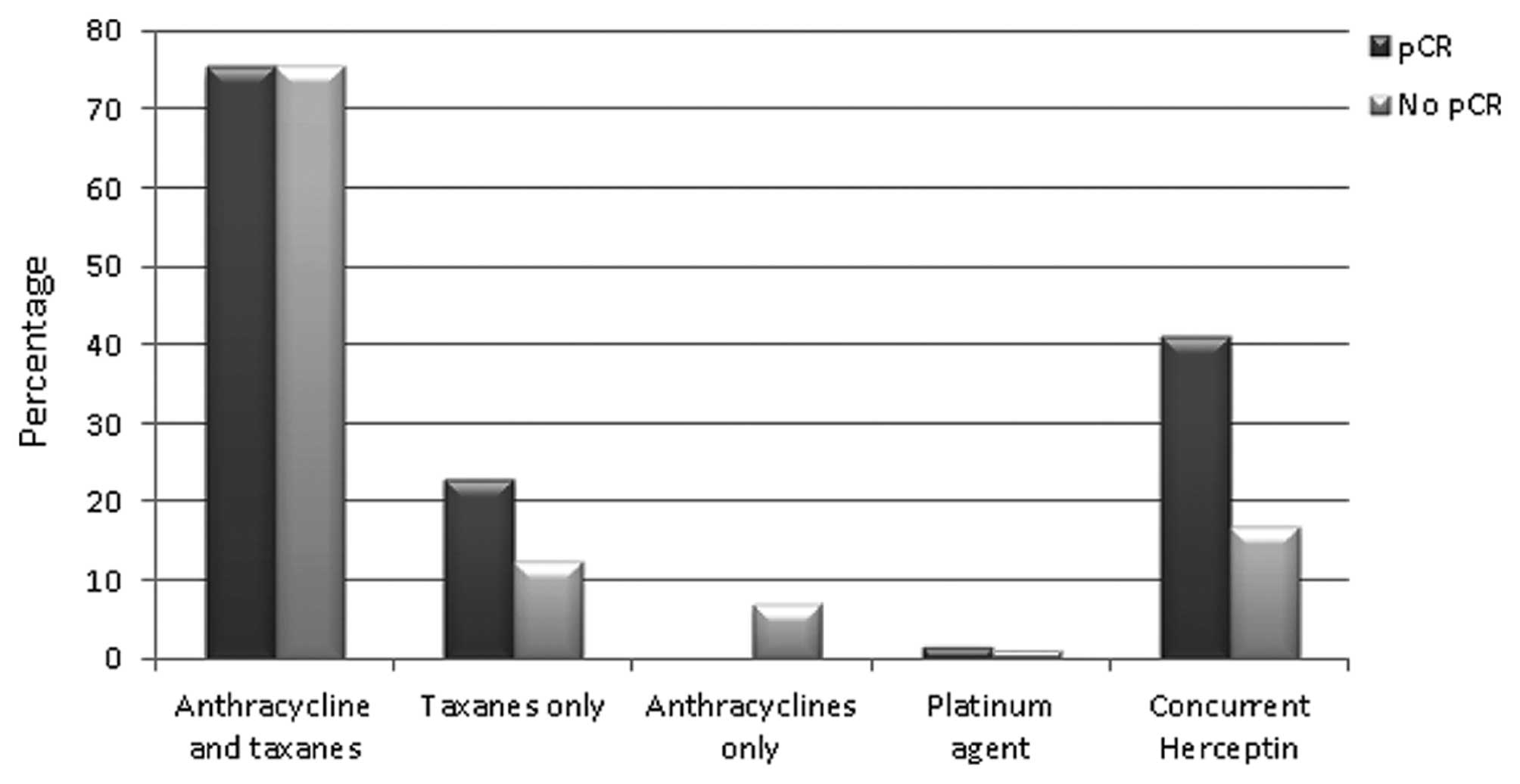|
1
|
Fisher B, Bryant J, Wolmark N, et al:
Effect of preoperative chemotherapy on the outcome of women with
operable breast cancer. J Clin Oncol. 16:2672–2685. 1998.PubMed/NCBI
|
|
2
|
Wolmark N, Wang J, Mamounas E, Bryant J
and Fisher B: Preoperative chemotherapy in patients with operable
breast cancer: Nine-year results from National Surgical Adjuvant
Breast and Bowel Project B-18. J Natl Cancer Inst Monogr.
30:96–102. 2001. View Article : Google Scholar : PubMed/NCBI
|
|
3
|
Van der Hage JA, van de Velde CJ, Julien
JP, Tubiana-Hulin M, Vandervelden C and Duchateau L: Preoperative
chemotherapy in primary operable breast cancer: Results from the
European Organization for Research and Treatment of Cancer trial
10902. J Clin Oncol. 19:4224–4237. 2001.PubMed/NCBI
|
|
4
|
Kong X, Moran MS, Zhang N, Haffty B and
Yang Q: Meta-analysis confirms achieving pathological complete
response after neoadjuvant chemotherapy predicts favourable
prognosis for breast cancer patients. Eur J Cancer. 47:2084–2090.
2011. View Article : Google Scholar : PubMed/NCBI
|
|
5
|
Rastogi P, Anderson SJ, Bear HD, et al:
Preoperative chemotherapy: Updates of National Surgical Adjuvant
Breast and Bowel Project Protocols B-18 and B-27. J Clin Oncol.
26:778–785. 2008. View Article : Google Scholar : PubMed/NCBI
|
|
6
|
Di Cosimo S, Arpino G and Generali D:
Neoadjuvant treatment of HER2 and hormone-receptor positive breast
cancer - moving beyond pathological complete response. Breast.
23:188–192. 2014. View Article : Google Scholar : PubMed/NCBI
|
|
7
|
Hirano A, Shimizu T, Imamura H, et al: The
combination of epirubicin plus docetaxel as neoadjuvant
chemotherapy in locally-advanced breast cancer. Anticancer Res.
26:(1b). 581–584. 2006.PubMed/NCBI
|
|
8
|
Gianni L, Eiermann W, Semiglazov V, et al:
Neoadjuvant and adjuvant trastuzumab in patients with HER2-positive
locally advanced breast cancer (NOAH): Follow-up of a randomised
controlled superiority trial with a parallel HER2-negative cohort.
Lancet Oncol. 15:640–647. 2014. View Article : Google Scholar : PubMed/NCBI
|
|
9
|
McCarthy N, Boyle F, Zdenkowski N, et al:
Australia and New Zealand Breast Cancer Trials Group: Neoadjuvant
chemotherapy with sequential anthracycline-docetaxel with
gemcitabine for large operable or locally advanced breast cancer:
ANZ 0502 (NeoGem). Breast. 23:142–151. 2014. View Article : Google Scholar : PubMed/NCBI
|
|
10
|
Bear HD, Anderson S, Smith RE, et al:
Sequential preoperative or postoperative docetaxel added to
preoperative doxorubicin plus cyclophosphamide for operable breast
cancer: National Surgical Adjuvant Breast and Bowel Project
Protocol B-27. J Clin Oncol. 24:2019–2027. 2006. View Article : Google Scholar : PubMed/NCBI
|
|
11
|
Mazouni C, Peintinger F, Wan-Kau S, et al:
Residual ductal carcinoma in situ in patients with complete
eradication of invasive breast cancer after neoadjuvant
chemotherapy does not adversely affect patient outcome. J Clin
Oncol. 25:2650–2655. 2007. View Article : Google Scholar : PubMed/NCBI
|
|
12
|
Von Minckwitz G, Untch M, Blohmer JU, et
al: Definition and impact of pathologic complete response on
prognosis after neoadjuvant chemotherapy in various intrinsic
breast cancer subtypes. J Clin Oncol. 30:1796–1804. 2012.
View Article : Google Scholar : PubMed/NCBI
|
|
13
|
Cataliotti L, Buzdar AU, Noguchi S, et al:
Comparison of anastrozole versus tamoxifen as preoperative therapy
in postmenopausal women with hormone receptor-positive breast
cancer: The pre-operative ‘Arimidex’ compared to tamoxifen (PROACT)
trial. Cancer. 106:2095–2103. 2006. View Article : Google Scholar : PubMed/NCBI
|
|
14
|
Semiglazov VF, Semiglazov VV, Dashyan GA,
et al: Phase 2 randomized trial of primary endocrine therapy versus
chemotherapy in postmenopausal patients with estrogen
receptor-positive breast cancer. Cancer. 110:244–254. 2007.
View Article : Google Scholar : PubMed/NCBI
|
|
15
|
Ellis MJ, Suman VJ, Hoog J, et al:
Randomized phase II neoadjuvant comparison between letrozole,
anastrozole, and exemestane for postmenopausal women with estrogen
receptor-rich stage 2 to 3 breast cancer: Clinical and biomarker
outcomes and predictive value of the baseline PAM50-based intrinsic
subtype - ACOSOG Z1031. J Clin Oncol. 29:2342–2349. 2011.
View Article : Google Scholar : PubMed/NCBI
|
|
16
|
Tan MC, Al Mushawah F, Gao F, et al:
Predictors of complete pathological response after neoadjuvant
systemic therapy for breast cancer. Am J Surg. 198:520–525. 2009.
View Article : Google Scholar : PubMed/NCBI
|
|
17
|
Harari D and Yarden Y: Molecular
mechanisms underlying ErbB2/HER2 action in breast cancer. Oncogene.
19:6102–6114. 2000. View Article : Google Scholar : PubMed/NCBI
|
|
18
|
McCready DR, Hortobagyi GN, Kau SW, et al:
The prognostic significance of lymph node metastases after
preoperative chemotherapy for locally advanced breast cancer. Arch
Surg. 124:21–25. 1989. View Article : Google Scholar : PubMed/NCBI
|
|
19
|
Goldhirsch A, Wood WC, Coates AS, Gelber
RD, Thürlimann B and Senn HJ: Panel members: Strategies for
subtypes - dealing with the diversity of breast cancer: Highlights
of the St. Gallen International Expert Consensus on the Primary
Therapy of Early Breast Cancer 2011. Ann Oncol. 22:1736–1747. 2011.
View Article : Google Scholar : PubMed/NCBI
|
|
20
|
Petrelli F, Coinu A, Borgonovo K, Cabiddu
M, Ghilardi M, Lonati V and Barni S: The value of platinum agents
as neoadjuvant chemotherapy in triple-negative breast cancers: A
systematic review and meta-analysis. Breast Cancer Res Treat.
144:223–232. 2014. View Article : Google Scholar : PubMed/NCBI
|
|
21
|
Silver DP, Richardson AL, Eklund AC, et
al: Efficacy of neoadjuvant cisplatin in triple-negative breast
cancer. J Clin Oncol. 28:1145–1153. 2010. View Article : Google Scholar : PubMed/NCBI
|















